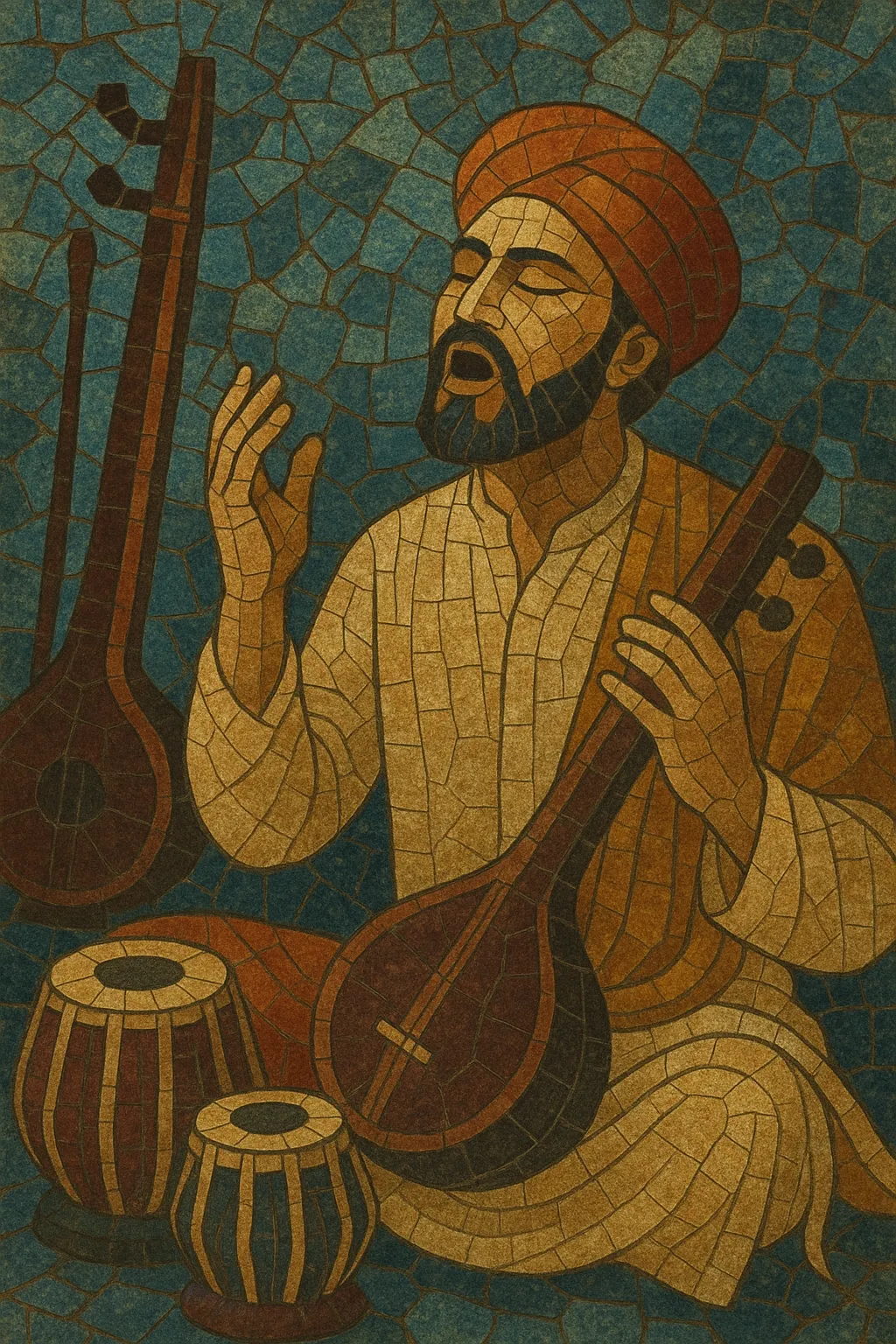Khyal (often spelled khayal) is the principal improvisatory vocal genre of North Indian (Hindustani) classical music. The word means “imagination,” and the style celebrates inventive melodic expansion within the strict grammar of raga and tala.
A typical performance centers on two compositions (bandish): a slow, expansive vilambit or bada khyal followed by a fast drut or chhota khyal. Singers develop the raga through alap-like vistaar (melodic elaboration), bol-alap and bol-bant (text-based improvisation), sargam passages (solfège), and taans (fast, cascading runs) that culminate on the sam (downbeat).
Khyal emphasizes microtonal nuance and vocal ornamentation—meend (glides), andolan (slow oscillations), gamak (heavy shakes), and intricate layakari (rhythmic play). It is accompanied by a tanpura drone, tabla in a chosen tala (often teentaal, ektal, or jhoomra), and a melodic support instrument such as sarangi or harmonium. Over the last two centuries, distinct gharanas (schools) have shaped its aesthetics, including Gwalior, Agra, Kirana, Jaipur-Atrauli, Patiala, Mewati, and Rampur-Sahaswan.
Khyal crystallized in North India during the 1700s under Mughal and regional court patronage. While it inherited the raga–tala framework from the older, austere dhrupad, khyal embraced a more lyrical and imaginative approach, likely absorbing elements from Persian musical aesthetics and Sufi practices in the courtly milieu. Court composers Niyamat Khan “Sadarang” and Firoz Khan “Adarang,” active during the reign of Muhammad Shah “Rangila,” codified many bandish that remain core repertoire.
As imperial power waned, princely states and regional courts (Gwalior, Agra, Jaipur, Rampur, Baroda, etc.) became vital patrons. Distinct gharanas emerged, each prioritizing different facets of khyal: Gwalior (foundational pedagogy and balanced aesthetics), Agra (dhrupad-influenced robustness and bol-bant), Kirana (slow, meditative swara purity), Jaipur-Atrauli (complex raga architecture and rare jod-ragas), Patiala (lyricism and virtuosic taans), and later Mewati and Rampur-Sahaswan.
With the advent of recording, radio, and concert sabhas, khyal left the court and reached national audiences. Pioneers such as Abdul Karim Khan, Faiyaz Khan, Kesarbai Kerkar, Bade Ghulam Ali Khan, Amir Khan, and Bhimsen Joshi defined modern performance ideals. After independence, institutions like All India Radio and Sangeet Natak Akademi, as well as university departments, supported pedagogy and documentation.
Global concert circuits, conservatories, and cross-cultural collaborations introduced khyal to wider audiences. While gharana identities remain meaningful, many singers today blend approaches, expanding the repertoire of bandish and exploring concert formats that include vilambit–drut pairs, tarana, and occasional semi-classical items. Digital archives and pedagogy have further preserved rare ragas and styles.
Select a raga with clear aroha–avaroha (ascent/descent), vadi–samvadi (primary/secondary tones), and signature phrases (pakad). Pair it with a tala suited to the desired pace: vilambit ektal (12), vilambit teentaal (16), jhoomra (14) for the slow section; teentaal, ektal, or drut teentaal for the fast section.
Write a bada khyal (vilambit) and a chhota khyal (drut) in Hindi/Urdu/Braj Bhasha, ensuring the melody honors the raga’s grammar and time-of-day/seasonal associations. Keep the mukhda (refrain) strong and sam-oriented, and craft the antara to explore upper register tones.
Begin with alap-like, unhurried vistaar over the tala, focusing on meend, andolan, and careful intonation. Use bol-alap and bol-bant to reshape the text rhythmically, and sargam passages to highlight tonal architecture without violating raga rules.
Introduce layakari (dugun/tigun/chaugun, syncopation) against the tala, always resolving authoritatively to the sam. Construct taans—sapat (straight), gamak-taan (shaken), sargam-taan, and bol-taan—in logically grouped phrases that outline the raga and climax toward cadential tihai patterns.
Use a tanpura drone (or electronic tanpura), tabla for tala articulation, and sarangi or harmonium for melodic support. Coordinate cueing with accompanists, leave space for tabla thekas and laggis in drut, and maintain clear sam landings. Prioritize breath control, microtonal accuracy, and aesthetically coherent pacing.
Daily riyaz should cover swara stability (akar), meend control, slow-tempo sustain, and progressive taan speed, always under the guidance of a guru to internalize stylistic nuances of a chosen gharana.


